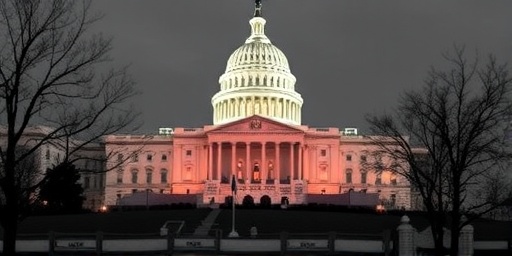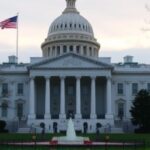The recent federal Government shutdown, triggered by partisan disputes over spending priorities, could inflict up to $14 billion in lost economic output on the U.S. economy, according to a stark new report from the Congressional Budget Office (CBO). This estimate highlights the immediate fiscal strain caused by halted federal spending, but economists caution that the true economic impact may extend far beyond these figures, potentially dragging on growth for months to come.
- CBO’s Stark Projection: Quantifying Shutdown’s $14 Billion Toll
- Ripple Effects: How Shutdown Disrupts Broader Economic Sectors
- Federal Workers Bear the Brunt: Personal Stories Amid Economic Chaos
- Historical Echoes: Lessons from Past Shutdowns and Their Growing Costs
- Charting a Path Forward: Mitigating Future Shutdown Risks and Economic Fallout
CBO’s Stark Projection: Quantifying Shutdown’s $14 Billion Toll
In its latest analysis released on Thursday, the CBO detailed how the 35-day Government shutdown—from December 22, 2018, to January 25, 2019—disrupted key economic activities across the nation. The nonpartisan agency calculated that the shutdown led to a direct loss of approximately $11 billion in federal spending that failed to materialize during the period. However, when factoring in reduced productivity from furloughed workers and delayed private sector transactions, the total lost output climbs to $14 billion, equivalent to about 0.4% of the U.S. gross domestic product (GDP) for the fourth quarter of 2018.
The CBO emphasized that this figure represents a conservative estimate. ‘The shutdown directly reduced the amount of goods and services provided by the government during the period it lasted,’ the report states. ‘In addition, it indirectly reduced the provision of some private services.’ Federal agencies, including the Departments of Agriculture, Commerce, and Justice, were among the hardest hit, with over 800,000 civilian employees furloughed without pay, leading to widespread service interruptions.
Breaking down the numbers further, the CBO report highlights that mandatory spending programs like Social Security and Medicare continued uninterrupted, shielding some sectors from the brunt. Yet discretionary federal spending, which funds everything from national parks to research grants, ground to a halt. This freeze not only idled government workers but also stalled contracts with private vendors, amplifying the economic impact. For instance, the Small Business Administration paused loan approvals, affecting thousands of entrepreneurs reliant on federal backing.
Ripple Effects: How Shutdown Disrupts Broader Economic Sectors
Beyond the immediate lost output, the Government shutdown‘s economic impact reverberates through supply chains, consumer confidence, and investment decisions. Economists from institutions like the Brookings Institution warn that the real cost could exceed $20 billion when accounting for long-term spillover effects. ‘Every day of shutdown erodes economic momentum,’ said Mark Zandi, chief economist at Moody’s Analytics, in a recent interview. ‘Businesses delay hiring, consumers cut back spending, and the uncertainty lingers.’
One of the most visible disruptions occurred in the housing market, where the shutdown delayed mortgage approvals and government-backed loans. The Federal Housing Finance Agency reported a 20% drop in loan processing during the closure, stranding homebuyers and contributing to a slowdown in real estate transactions. Similarly, the travel and tourism industry suffered as national landmarks like the Smithsonian museums and Yosemite National Park closed their doors, costing an estimated $200 million in lost visitor revenue alone, according to the U.S. Travel Association.
Federal spending cuts during the shutdown also hit agriculture hard. Farmers awaiting subsidies and inspections faced delays, exacerbating financial pressures amid ongoing trade tensions. The American Farm Bureau Federation noted that over 10,000 meat and poultry inspections were postponed, leading to supply chain bottlenecks and potential food price hikes. In the tech sector, NASA’s temporary halt on operations delayed satellite launches and research collaborations, underscoring how even short-term pauses can jeopardize innovation pipelines.
Moreover, the economic impact extended to international trade. The closure of the Commerce Department’s International Trade Administration slowed tariff investigations and export promotions, potentially costing U.S. exporters millions in lost opportunities. A study by the Peterson Institute for International Economics projected that prolonged uncertainty could shave an additional 0.1% off annual GDP growth if similar shutdowns recur.
Federal Workers Bear the Brunt: Personal Stories Amid Economic Chaos
At the heart of the government shutdown’s toll are the roughly 800,000 federal employees who went without paychecks, many for the first time in their careers. These workers, from air traffic controllers to IRS auditors, faced immediate financial hardship, dipping into savings or relying on food banks. ‘It’s not just numbers on a page; it’s families struggling to pay rent and buy groceries,’ said Rep. Nancy Pelosi, D-Calif., in a floor speech shortly after the shutdown ended.
The CBO report quantifies this human cost indirectly, estimating that furloughed workers’ lost wages alone accounted for about $3 billion of the total economic impact. Many employees, including those at the Environmental Protection Agency and the National Institutes of Health, returned to work only to face massive backlogs. For example, the IRS reported a pileup of over 13 million tax returns awaiting processing, which could delay refunds for millions of Americans and slow economic stimulus from those payments.
Contractors and vendors, often overlooked in official tallies, felt the pinch even more acutely. Small businesses dependent on government contracts, such as those providing IT services to the Department of Defense, saw revenues plummet. The Professional Services Council, representing such firms, estimated that its members lost $1.5 billion in billings during the shutdown. One contractor in Virginia, speaking anonymously to Reuters, described the ordeal: ‘We had to lay off 50 employees just to survive. The government’s delay in payments is like a domino effect on our entire operation.’
Women and minority workers, who make up a significant portion of the federal workforce, were disproportionately affected. Data from the Office of Personnel Management shows that 44% of federal employees are women, and the shutdown’s wage delays exacerbated existing gender pay gaps. Advocacy groups like the National Women’s Law Center called for enhanced protections, including interest on back pay, to mitigate these inequities.
Historical Echoes: Lessons from Past Shutdowns and Their Growing Costs
This isn’t the first time a government shutdown has tested the U.S. economy, but each iteration seems to amplify the damage. The CBO’s analysis draws parallels to the 2013 shutdown, which lasted 16 days and cost about $24 billion in lost output—far more per day than the recent event due to its timing during peak economic activity. In contrast, the 1995-1996 shutdowns, totaling 21 days, were estimated at $1.4 billion, adjusted for inflation, revealing how interconnected modern economies have become.
Over the past two decades, there have been 21 funding gaps leading to partial shutdowns, according to the Pew Research Center. The economic impact has escalated with the growth of federal spending, which now accounts for nearly 21% of GDP. The recent shutdown, the longest in history, surpassed the 1995-1996 record and highlighted vulnerabilities in an era of rising national debt, now exceeding $22 trillion.
Experts point to partisan gridlock as the root cause, with disputes over border wall funding and disaster relief bills precipitating the impasse. Senate Majority Leader Mitch McConnell, R-Ky., defended the administration’s stance, stating, ‘We must prioritize national security funding.’ Yet, bipartisan frustration is mounting, with a recent poll by Quinnipiac University showing 70% of Americans blaming both parties equally for the shutdown.
The CBO warns that repeated shutdown threats could erode investor confidence, leading to higher borrowing costs for the government. Federal spending volatility also complicates monetary policy, as the Federal Reserve grapples with balancing inflation and growth amid fiscal uncertainty.
Charting a Path Forward: Mitigating Future Shutdown Risks and Economic Fallout
As Congress works to pass a comprehensive budget agreement, the focus shifts to preventing future disruptions. Bipartisan proposals, including automatic continuing resolutions to fund the government at prior levels during impasses, are gaining traction. House Speaker Pelosi has championed such measures, arguing they would ‘protect American workers and the economy from political brinkmanship.’
Economists urge swift implementation of back pay for federal workers and accelerated processing of delayed services to minimize lingering effects. The International Monetary Fund (IMF) has advised that stabilizing federal spending is crucial for maintaining U.S. credibility in global markets, potentially averting a credit rating downgrade.
Looking ahead, the CBO projects that if shutdowns become annualized events, cumulative lost output could reach $100 billion by 2025, stifling job creation and widening income inequality. With midterm elections influencing fiscal debates, pressure is on lawmakers to reform the budgeting process. Initiatives like the Bipartisan Budget Act of 2019 aim to provide short-term relief, but long-term solutions—such as balanced budget amendments or independent fiscal commissions—remain under discussion.
In the meantime, businesses are advised to diversify revenue streams away from heavy federal reliance. The U.S. Chamber of Commerce recommends contingency planning, including cash reserves for potential disruptions. As the economy rebounds from this shutdown, the $14 billion scar serves as a reminder of the high stakes in Washington’s fiscal battles, urging a renewed commitment to stable governance.









